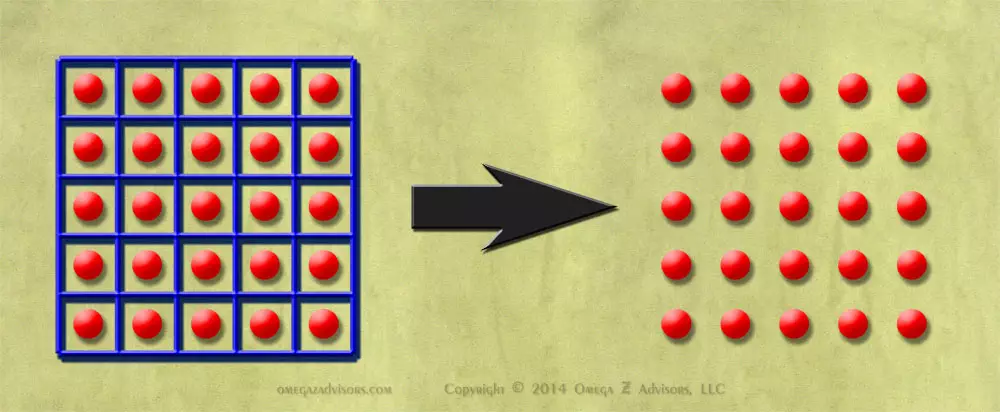Attacking Relational Challenges in Group Interactions
- Group Interactions, Molding Relationships and Culture
- Group Interactions, the Two Types and Their Ratio
- Attacking Relational Challenges in Group Interactions
- Initiating Questions and Comments in Group Interactions
- Encouraging More Questions in Group Interactions
- Forming and Tapping Relationships in a Group Interaction
- Leveraging Group Interactions Afterwards
- Advance Work for Positioning Group Interactions
- Leveraging Group Interactions The Complete Strategy
When tapping group interactions to mold relationships and culture, the relational challenges center on groups naturally constraining individual expression. We frequently experience this in large meetings when no one says anything unless prompted.

The relational challenge in group interactions is to get everyone to come out of their boxes (their shells) so we can mold relationships and business cultures.
Consequently, as visualized in the left schematic of the figure, every person is in his own box, his own safe space which allows withdrawal and protection by not saying or doing anything to draw attention. He isolates himself from us and the team. It’s similar to withdrawing physically when people enter his personal space. Thus, removing these boxes, as visually expressed in the right schematic, is the relational challenge.
Typically, we express feelings of constraint as peer pressure and conformity. Attendees though have many ways to rationalize them such as:
- This isn’t the time or place to ask my question.
- My comment really isn’t pertinent.
- I should have worn something more professional (or more casual).
- The presenter doesn’t really want to hear what I have to say.
- I’m wearing the same thing that person is.
- This topic really isn’t that important to me (or doesn’t apply to me).
- I didn’t want to attend; my boss told me to be here.
- They’ll probably think my comment stupid, and I’ll look foolish.
These feelings intensify with such factors as:
- Large group
- Extensive formality
- Serious occasion
- Multiple hierarchical levels present
- Many unfamiliar people
- Diverse personalities, departments, teams or culture
Whether a straight presentation or an interactive format, we can remove these boxes in such basic ways as:
- Encourage questions and comments
- Address and mention individuals by name
- Make positive references and compliments about individuals
- Reference everyone in some way either as individual or part of a team or project
Removing these boxes will foster the integration necessary to mold relationships and business cultures.



It’s too late to be truly effective if the leader comes into the session and has to take the lead in removing the barriers / getting others to participate. It has to be the organization culture that (1) everyone is important, (2) it’s the people present that offer the best opportunities for success, (3) no one is perfect (everyone makes some less than stellar comments), (4) no one is useless (everyone will make important comments, and (5) every person has had different experiences and represents a different culture AND thus has unique offerings to make.
So, yes, it’s too late really if each person doesn’t come into the room expecting to engage! It’s the leaders’ responsibility to provide the environment which will enable such to happen. How about discussions among all employees on developing company culture? How about an environment where feedback is honest AND cab be positive or negative – but not associated with automatic penalties or rewards only, rather an expectation of continued improvement? How about an expectation that everyone’s efforts will include “development of new ideas?” How about a careful review of the meeting agendas to see if it’s important and consistent with the organization culture?
Meetings that are relevant and are aligned with organization culture will be welcomed, not dreaded. THEN the suggestions in the post for leader action will happen pretty much automatically and will have positive impact!
John, the items you mention are important. What is here are the tactics to create the conditions of which you write. Each of the points you mention cannot succeed unless relationships are there. The culture is formed by these relationships. The five points you mention are very good attributes. What I am illustrating in this series of posts are the RELATIONAL tactics to create those attributes. It’s at the meetings, presentations and interpersonal interactions where these relational tactics are applied to create the conditions that will allow us to do everything you outlined. What you present are goals. What I present are relational tactics aimed to achieve those goals.
It’s not too late to begin changing things at any time. You’re right though. It won’t change at one meeting or even two. Yet, building upon the relationships and cultures molded at such meetings followed up by successful interpersonal interactions, it will change.
For example, the expectation that everyone’s efforts will include “development of new ideas.” It’s right on. The problem is that you cannot force new ideas. They arise when relationships and culture are strong. As another, a careful review of meeting agendas is very important to see if consistent with organization culture. That is important but again without strong relationships we are just trying to repair relationships and culture with words. That alone doesn’t work.
Behind each and everyone of your ideas, what are the emotions behind them? How are we trying to mold them? The answers lie in the how we address the emotional elements, the relational elements of each and every group and individual interaction we have. It’s never too late to change . . . even at a meeting.
Again, the best way to assess what I am presenting is to look at them as the tactics to achieve everything you mention.
I believe we’re saying the same thing in somewhat different ways: culture, relationships, discussions, expectations.
I believe we are too, John. Thank you again for your insights.